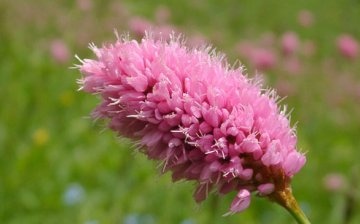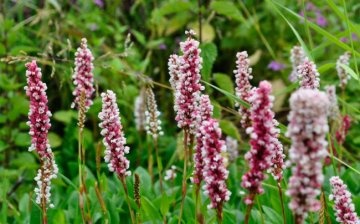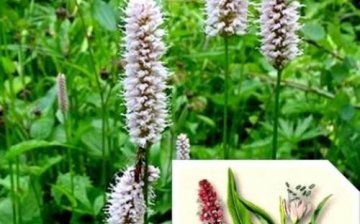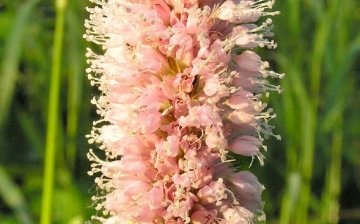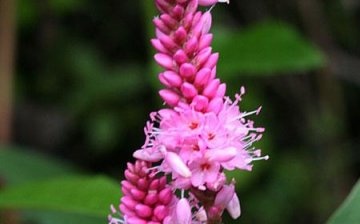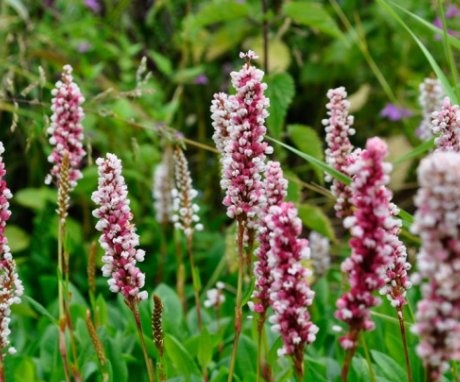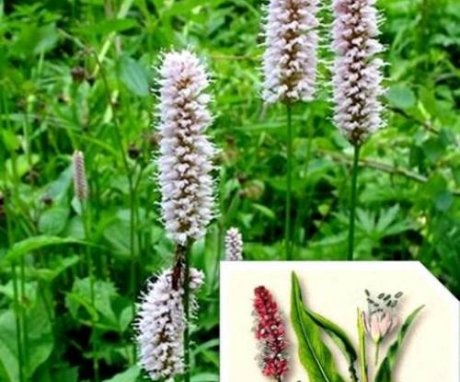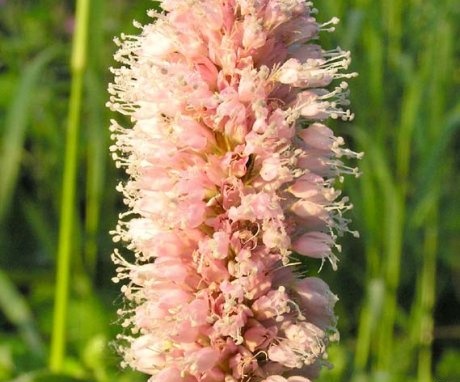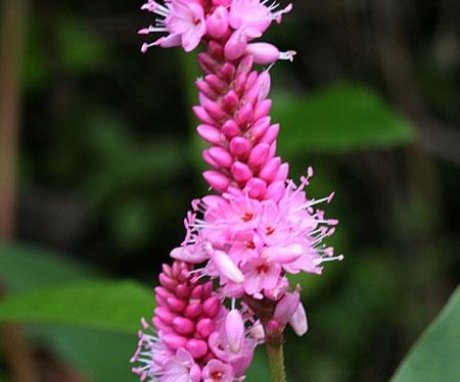Variety of species of the highlander flower, features of its home cultivation and reproduction
Highlander flower is a perennial plant, it can be herbaceous, liana-like, shrub. It is very simple to grow it at home; it does not impose any requirements other than moistened soil.
Content:
- What does a highlander look like and its main features
- Variety of types of highlander
- Types used in traditional medicine
- Growing and care
- Breeding methods
What does a highlander look like and its main features
Highlander flower (polygonum) - perennial herb, belongs to the buckwheat family. In total, there are about 300 different types of mountaineer in the world, 20 of which can be grown at home.
Depending on the species, the mountaineer can be not only herbaceous, but also in the form of a dwarf shrub and even a liana. All highlanders have common similarities that unite them into one genus.
Highlander description:
- Stems are open, erect, small flowers, collected in an inflorescence panicle or brush.
- The root system of the mountaineer is well developed, the rhizome is either creeping or erect.
- Leaves are simple lanceolate-ovate, alternate arrangement.
- The fruit of the mountaineer flower is a nut, it contains a large number of seeds.
- The color of flowers can be very diverse, ranging from white to red and burgundy. The flowering period lasts from July to August.
Highlander is very popular in home floriculture. In one composition can different types of... For example, the amphibian mountaineer is used to decorate water bodies, it partially submerges in water, and part of it peeps out. The Serpentine Highlander stretches along the shores of reservoirs.
The plant does not like acidic soils, develops well in shaded areas, does not need moisture.
These are ideal conditions for the lazy gardener who does not have time to spend a lot of time on the site, but wants to decorate his garden. If there was little snow in winter, then this may turn out to be negative for the mountaineer. After winter, the highlander will look sloppy, but very soon he will take on his usual shape.
Liana-like highlanders are used for vertical gardening. Herbaceous and semi-shrub species are planted in curbs, rock gardens, etc. Alpine species can be used for specimen plantings.
In nature, the mountaineer is found in the steppes and mountainous areas in the countries of the Northern Hemisphere, in temperate latitudes. The mountaineer endures winter without shelter, he is unpretentious, in its properties it resembles a weed, although very decorative.
Some types of mountaineer are even used in folk medicine.
Variety of highlander species
Gardeners most often use the following types of highlander:
- Alpine highlander is a semi-shrub plant. The maximum height is 1.5 meters, the stems can divide and branch to unlimited sizes. The flowers are white, gathered in a panicle. It is the most popular among other species of highlander, as it actively develops and blooms profusely. The flowering period begins in July.
- Highlander is a related herb that covers the ground. The maximum height is no more than 25 cm, the stems are raised above the soil.The plant is evergreen, the leaves can be oval or oblong-lanceolate. Flowers are collected in an inflorescence of spikes, themselves very small, red-pink hue. It begins to bloom in May.
- Highlander Sakhalin, or as it is also called Sakhalin sinner, is a perennial herb. Differs in straight strong stems, can grow up to 3 meters in height, green leaves with a brown tint. The leaves are large, the maximum length is 30 cm, the maximum width is 20 cm. The flowers are small, of a pastel-cream shade, collected in panicles 20 cm long. It begins to bloom in July.
- Knotweed is a shrub plant, the stems grow 80-120 cm in height. The leaves are wide, by autumn they begin to turn yellow. The flowers are collected in a spikelet inflorescence, begins to bloom in August, the flowering period lasts 2 months.
There is another classification according to which the mountaineers are divided according to the type: tall or short.
Among tall plants, gardeners successfully grow:
- The eastern highlander grows up to 2 meters in height, the inflorescences are large. Flowers can be white, red, pink, lilac. The leaves are pointed; after flowering, large nuts remain. The flowering period lasts from August to the end of autumn. Loves wet soil, does not require special care.
- The Japanese knotweed grows in the form of a bush. Its maximum height is 5 meters. The branches are hollow, reminiscent bamboo stalks, the leaves are oval. The leaf differs in that light streaks are located on it. It begins to bloom at the end of September. In one season, a Japanese highlander can create an entire hedge.
Low-growing species:
- The capitate mountaineer is an annual plant that grows rapidly and covers the ground. The maximum height is 15 cm, the leaves have red streaks and spots. Inflorescences in the form of cones, small, not particularly prominent, pink flowers.
- Viviparous mountaineer - perennial, grows up to 45 cm. Stems are straight, leaves are dense, dark in color. Inflorescence of spikes, pink or red flowers, blooms throughout the season. The roots and flowers are eaten.
- Highlander Baldzhuan - grows in the form of a vine. The length of each shoot reaches a length of 12 meters. The main application of this type of mountaineer is vertical gardening. As the plant grows older, the stems become lignified. The flowers are small, pink in color. Leaves are dark green. The plant needs to be watered regularly, it loves moisture and cool air. The plant tolerates even the coldest winter, the vines freeze out, but the roots remain and give new shoots.
Each species is significantly different from the rest. You can understand belonging to the genus by the typical inflorescences.
Types used in traditional medicine
Highlander used in traditional medicine from a wide range of diseases. The plant treats eye diseases, problems of the gastrointestinal tract, gout.
The main properties of the highlander:
- Bactericidal.
- Astringent.
- Wound healing.
The most salubrious of all types are alpine and serpentine mountaineers. The snake mountaineer (crayfish necks, viper grass, veal tongue) has small flowers and a hollow stem. Flowers are collected in a spikelet inflorescence, can be red, pink and white.
You can grow a snake highlander on wet soil in a bright place. Under natural conditions, it grows in meadows and in mountainous areas. The maximum plant height is no more than 1 meter. For the preparation of medicinal recipes, all parts of the plant are used: roots, stems, leaves, flowers and seeds.
Raw materials are harvested in May, then it will have the most healing properties.
Highlander is a strong antiseptic that can stop bleeding and relieve inflammation:
- The snake mountaineer is indispensable for indigestion, for diseases of the gastrointestinal tract, gallbladder, for problems with the throat, oral cavity, for the healing of boils and purulent wounds.
- Alpine highlander (battering ram, kislets, mountain highlander) is a weed, although it is grown as ornamental plant... Bushes are wide and branched, up to 2 meters in diameter. The roots are large, penetrate deep into the ground.The flowers are white, gathered in a panicle inflorescence. The flowering period begins in mid-summer and can be found in meadows, steppes and even forests. It spreads quickly and requires little maintenance.
- Alpine mountaineer is used in the treatment of diseases of the stomach and intestines, diarrhea, dysentery, high blood pressure. The stems and leaves of plants contain a large amount of vitamin C, so they are used to treat colds and boost immunity.
- The bird knotweed (knotweed) grows in urban conditions, is not afraid of dust and trampling. The herb has a diuretic and astringent, stops bleeding. Water infusions using Knotweed are used for diseases of the gastrointestinal tract, diarrhea, diseases of the bladder, tuberculosis, whooping cough, etc.
Knotweed baths fight skin diseases, relieve bruising pains, and heal wounds.
Fresh herb extract is used as a homeopathic remedy. Despite the fact that the mountaineer is an aggressive weed plant, it is very decorative and very useful.
Growing and caring
It is not difficult to grow a mountaineer. All species have similar characteristics, however, many of them require special conditions. Highlander adapts well to cool conditions, he will actively grow and develop in partial shade, in conditions of high humidity. Highlander blooms best on fertile, moist soils, the choice should be on fertilized sandy loam or loamy soils, the reactions are slightly acidic or neutral.
The highlander himself looks like a weed, so he is not afraid of pests.
It is resistant to the most common diseases. The Knotweed prefers alkaline or neutral soils. The serpentine mountaineer is more fond of areas to which groundwater is close. But the splayed mountaineer, on the contrary, loves drier areas, that is, moderately moist.
Plant care secrets:
- During the summer season, plants are provided with moderate watering. Some species require abundant watering if there is no groundwater nearby.
- Okay the highlander belongs to fertilizers.
- It can tolerate drought and slight waterlogging, but being constantly in damp ground will feel bad.
- Young highlanders have a hard time tolerating autumn or spring frosts. Therefore, young plants are covered until summer. If the leaves die during the autumn frost, then the stems must be cut off immediately.
- In the fall, the leaves on some species begin to turn yellow, in this state they are all winter. With the onset of spring, the brown leaves are cut off, and at the end of autumn the entire plant is cut off.
- The first year, a young plant requires shelter for the winter. If Japanese, filamentous or small-headed knotweed is grown, then they spend the winter not in open ground, but in greenhouses.
There is another property of the mountaineer, for which some gardeners love him, and some refuse to grow. We are talking about strong overgrowth, even aggressiveness.
In one season, the shoots of a mountaineer can spread far beyond the bush, flesh up to several meters.
It is sometimes difficult to keep the plant within its limits. It must be constantly trimmed and weeded out, or you can watch the flower fill most of the garden. The main requirements are related to the choice of soil, light and moisture. Everyone can provide them.
Breeding methods
There are 4 breeding methods for the Highlander:
- Seeds.
- Cuttings.
- By dividing the rhizomes.
- Division of the bush.
Not all species can reproduce by all methods. Each species has its own preferences. If the method of dividing the bush is used, then the right time for this is spring or autumn. Cuttings are carried out in spring or summer. Depending on the species, the mountaineer is planted at a distance of 20-60 cm from each other. Highlander does not require an annual transplant; in one place it can develop up to 10 years.
Seed propagation is suitable for such species: spread out, snake, oriental.
Seeds are stratified and sown in late spring when the threat of frost has passed. Can be sown directly into open ground, or into boxes. Seedlings are transplanted into the ground along with a lump of earth.
Seed stratification lasts 2 months, for this they must be at a temperature of +5. Seeds are laid in the ground to a depth of 1 cm.
Highlander cuttings:
- Cuttings begin to prepare late spring early summer. There must be at least 2 knots in the scion. The cutting is processed by Kornevin or Heteroauxin.
- A bed is prepared in advance, which should be already warm by this time.
- Rooting will occur quickly if the soil temperature is several degrees warmer than the ambient temperature. Horse manure is laid at the base of the bed, fertile soil on top, sand mixed with peat on top in a ratio of 1 to 1.
- The lower knot of the cutting deepens by 1-2 cm. Further, the cutting is covered with polyethylene or lutrasil. This is necessary to maintain the microclimate. For the winter, the plant is dug up and stored at a temperature of no more than 2.
To prevent the highlander from spreading throughout the entire site, its growth is restrained using a cunning method: restraints are dug around the plant to a depth of 30 cm.
Rarely do gardeners breed a mountaineer, because it can quickly spread over the site without outside help.
Before choosing a certain type of highlander for home cultivation, you need to familiarize yourself with all its characteristics in order to ensure proper care. The garden area should be large in case the mountaineer starts to grow.
More information can be found in the video.



